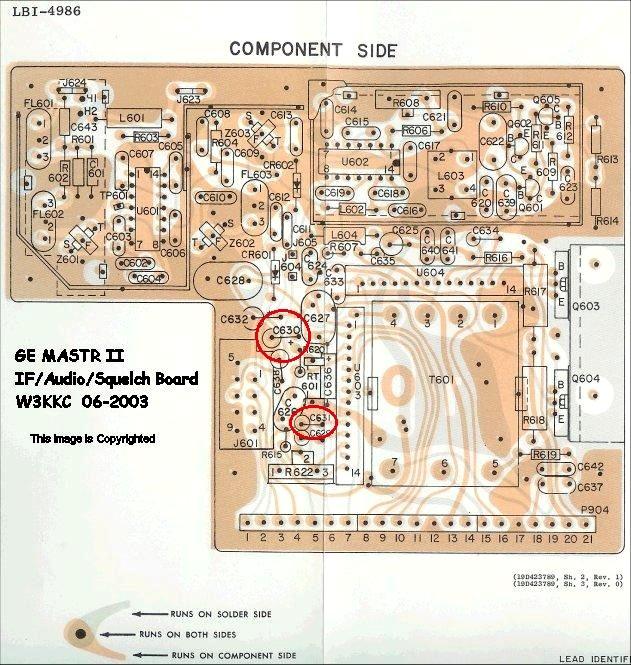
|
Up one level Back to Home |
Better Squelch Action on a GE MASTR II By M. Scott Zimmerman and Kevin K. Custer |
Concept:
Modify the bi-level squelch found in an unmodified GE MASTR II
radio for better performance.
Background information:
The performance of the stock GE bi-level (slow / fast) squelch leaves
much to be desired. The following modifications will improve the squelch
action, and make the GE squelch operation act more like the squelch circuitry
in a Motorola MICOR.
For more information on the details behind bi-level squelch,
click here.
Bryan Dorbert N3ST gave the suggestion of removing capacitor C630
on the IF/Audio Squelch Board. This capacitor, when removed, will disable
the Fast Squelch function. From the factory, in Station applications,
this capacitor is removed. With this capacitor removed, the
"popping" will be reduced when a user has mobile flutter.
(Editors note; Bryan's concept will work, however, all it does is disables the fast action; which totally defeats the dual mode squelch.) As such, we propose the following:
Modification information:
A better approach is to lengthen the amount of time the squelch
stays open on a marginal signal, but will still allow the squelch to close
immediately on a strong signal. This is accomplished by changing the value
of capacitor C631. Originally its value is .82 uF. Trial and error has
proven that a value of approximately 3.3 uF is a better value for this
capacitor. I would suggest a tantalum or other high quality
capacitor be used. Electrolytic types are ok, however they may change
value with temperature and this could be a problem in sites that aren't
environmentally controlled... you don't want your squelch action to be
your repeater building telemetry...
For this mod to work, C630 needs to be in place, so on a mobile don't
remove it.
On a Station, you'll need to install this capacitor as it was never
present. C630 is a 4.7 uF, 25 volt tantalum.
C631 can actually be the same value as C630, 4.7 uF, it seems that a 3.3 works fine, but
some prefer the slightly larger value.
After changing the value of capacitor C631 (and installing C630 if it is not present), the GE MASTR II's squelch will perform more like the famous Motorola MICOR, something that over time has proven to be the best noise squelch circuit for repeater operation, in many folks opinion.
Here's a layout of the System Audio and Squelch board, with both capacitor locations circled.

Here's a partial schematic with both capacitor locations circled. Click on it for a larger view.
Back to the top of the page
Up one level
Back to Home
HTML Copyright March 2002, Kevin K. Custer W3KKC
The information presented on this web site, in and on these conversion pages is ©
Copyrighted 1995-present by Kevin Custer W3KKC and multiple originating authors.